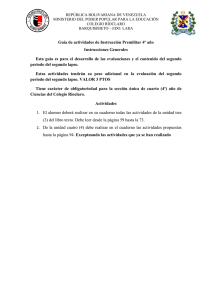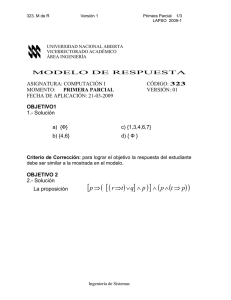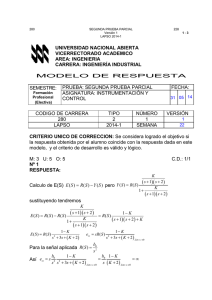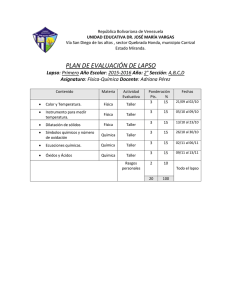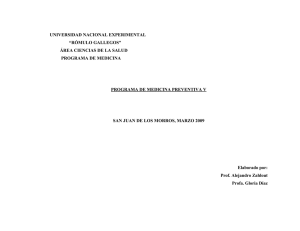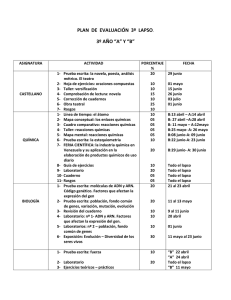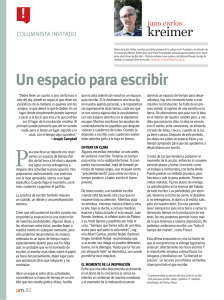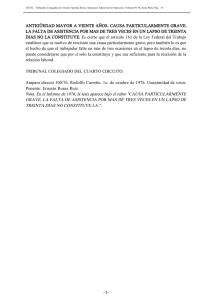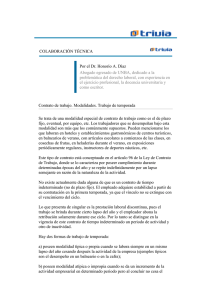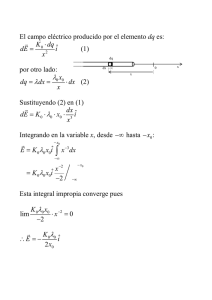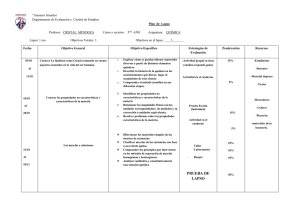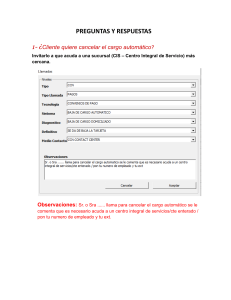K - CiberEsquina - Universidad Nacional Abierta
Anuncio
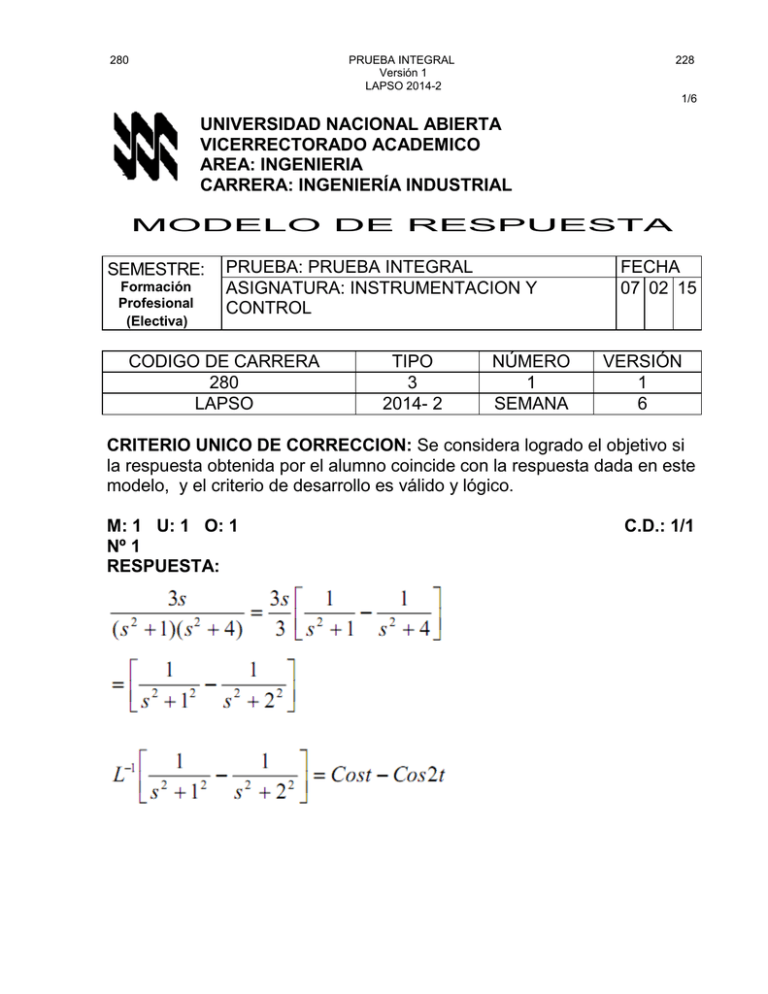
280 PRUEBA INTEGRAL Versión 1 LAPSO 2014-2 228 1/6 UNIVERSIDAD NACIONAL ABIERTA VICERRECTORADO ACADEMICO AREA: INGENIERIA CARRERA: INGENIERÍA INDUSTRIAL MODELO DE RESPUESTA SEMESTRE: Formación Profesional (Electiva) PRUEBA: PRUEBA INTEGRAL ASIGNATURA: INSTRUMENTACION Y CONTROL CODIGO DE CARRERA 280 LAPSO TIPO 3 2014- 2 NÚMERO 1 SEMANA FECHA 07 02 15 VERSIÓN 1 6 CRITERIO UNICO DE CORRECCION: Se considera logrado el objetivo si la respuesta obtenida por el alumno coincide con la respuesta dada en este modelo, y el criterio de desarrollo es válido y lógico. M: 1 U: 1 O: 1 Nº 1 RESPUESTA: C.D.: 1/1 280 PRUEBA INTEGRAL Versión 1 LAPSO 2014-2 228 2/6 M: 1 U: 2 O: 2 Nº2 RESPUESTA: C.D.: 1/1 M: 2 U: 3 O: 3 C.D.: 1/1 Nº 3 RESPUESTA: Del sistema dado se puede deducir las siguientes ecuaciones de comportamiento dinámico de cada resorte: K1 y F K2 x y F Eliminando y en estas dos ecuaciones resulta K K2 K F K2 x F K2 x F 2 F 1 F K K K 1 1 1 K K2 K2 x 1 F K 1 Para el sistema equivalente pedido la ecuación de comportamiento dinámico será: Keq x Keq x F K2 x K1K 2 1 Keq K1 K 2 K1 K2 1 1 K1 K 2 K1 280 PRUEBA INTEGRAL Versión 1 LAPSO 2014-2 228 3/6 M: 2 U: 4 O: 4 Nº4 RESPUESTA: La función de transferencia global está dada por: C.D.: 1/1 10 G S S S 1 S 4 10 3 10 K 1 G S H S 1 S 5S 2 4S 10 K S S 1 S 4 El arreglo de Routh para el denominador es: S3 S2 S1 S0 1 4 5 10 K 4 2K 10 K Para que la primera columna solo tenga valores positivos se debe tener: 4 2 K 0 K 2 Esto significa 0 K 2 10 K 0 K 0 M: 3 U: 5 O: 5 Nº 5 RESPUESTA: Calculo de E(S) E(S ) R(S ) C(S ) pero C.D.: 1/1 K s 3 s s 1 K s 3 C ( S ) R( S ) R( S ) sustituyendo tendremos: K s 3 s s 1 K s 3 1 s s 1 E ( S ) R( S ) R( S ) E ( S ) R( S ) K s 3 s s 1 R( S ) s s 1 K s 3 s s 1 K s 3 s s 1 s s 1 K s 3 ess sR( S ) Para la señal aplicada R( S ) b0 s s s 1 s s 1 K s 3 Lim s0 280 PRUEBA INTEGRAL Versión 1 LAPSO 2014-2 228 4/6 Así ess b0 s s 1 0 s s 1 K s 3 Lim s0 M: 3 U: 6 O: 6 C.D.: 1/1 Nº 6 RESPUESTA: El sistema es inestable cuando el lugar de raíces cruza el eje imaginario hacia el semiplano derecho, lo cual se produce cuando K = 150 y ω=+ -5. También la rama del lugar de raíces sobre el eje real toca el eje imaginario a ω= 0 M: 3 U: 7 O: 7 C.D.: 1/1 Nº 7 RESPUESTA: Reordenando la ecuación de la función de transferencia para el tubo en U. 1 H s L P s s2 R s 2 g L L Identificando con la respuesta de un sistema de segundo orden 1 K L 1 K 2g 2g L G S 2 n2 n 2 R 2 g S 2n S n s 2 L L s L L R R R R L 2n L 2 Ln 2 g 2 2 g 2 L R L 2 2 g 280 PRUEBA INTEGRAL Versión 1 LAPSO 2014-2 228 5/6 M: 3 U: 8 O: 8 C.D.: 1/1 Nº 4 RESPUESTA: Para lograr estabilidad la magnitud no debe exceder de 1 cuando la fase es 180º 180º. La condición limitante para la fase es Tg 1 0 para lograr la estabilidad. La función de respuesta en frecuencia es: K j 1 j 1 2 j 1 Separando en parte real e imaginaria. K K G j j 1 2 2 j 1 2 1 j 1 2 3 2 1 2 j G j G j K 2 1 2 j 1 1 2 2 2 1 2 j 1 1 2 2 K G j . 2 1 2 j 1 1 2 2 2 1 2 j 1 1 2 2 G j K G j K 2 1 2 j 1 1 2 2 2 2 1 2 j 1 1 2 2 1 2 j 1 1 2 2 3 1 2 1 1 2 2 2 2 2 1 1 2 2 1 2 G j K j 2 3 2 2 3 2 1 2 2 1 2 1 1 2 1 2 1 2 K 1 2 j 1 1 2 2 G j 2 3 2 2 1 2 1 1 2 Fase: 1 1 2 2 1 1 2 2 1 G j Tg 0 1 1 2 2 0 1 2 1 2 1 2 1 280 PRUEBA INTEGRAL Versión 1 LAPSO 2014-2 228 6/6 Magnitud: G j K 3 1 2 1 1 2 2 2 Sustituyendo 2 2 1 1 2 K 1 1 2 2 1 1 2 2 2 1 3 1 2 1 2 1 2 1 1 1 2 1 2 2 1 1 2 2 1 1 2 1 1 2 1 1 2 K 1 K 1 2 1 2 1 2 1 2 FIN DEL MODELO DE RESPUESTA 2
